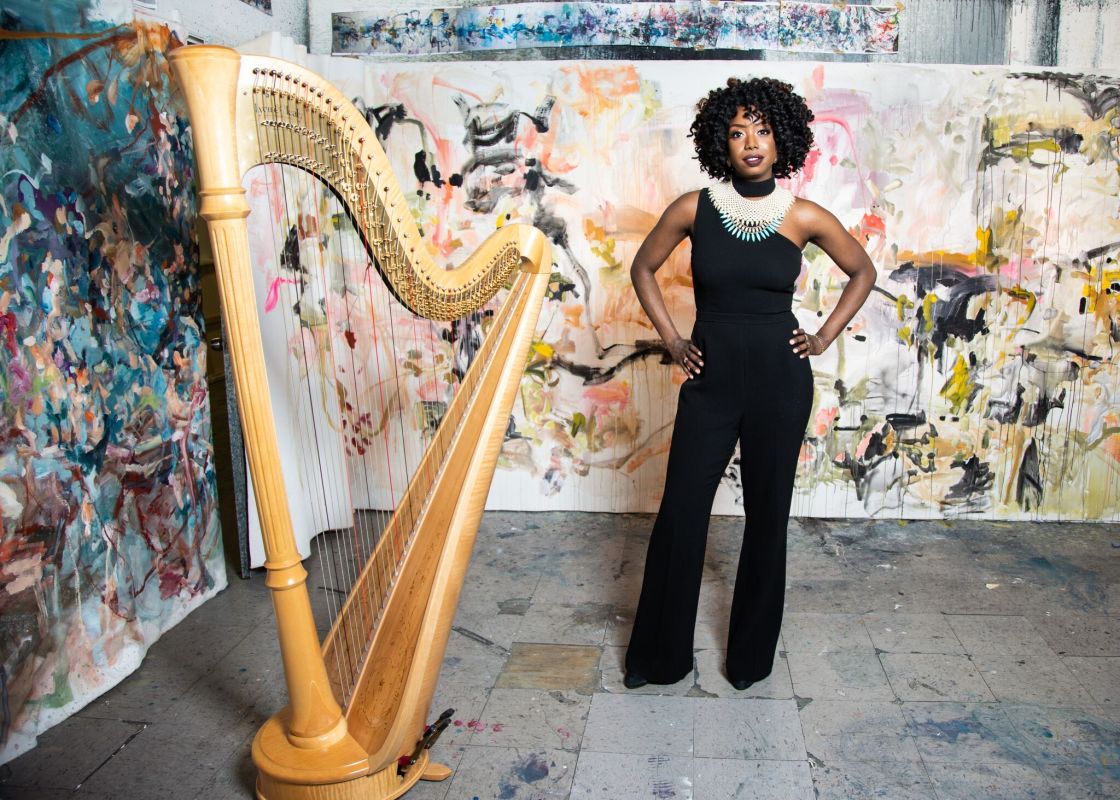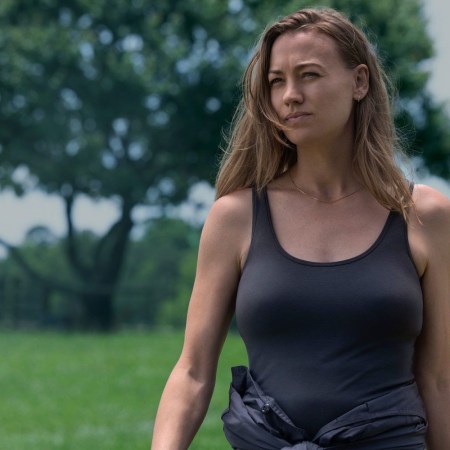Brandee Younger has just arrived for her gig at the Edition Hotel in New York City when two curious onlookers approach, wanting to know what the large, covered object she’s pushing on a dolly is.
She smiles patiently and tells them it’s a harp. The two men seem surprised.
“I thought it was a massage table,” one tells her. “I thought it was a bike,” the other offers before, satisfied with her answer, they stroll away. She shakes her head and laughs. “A bike?”
Younger, 35, is used to this kind of attention. It’s hard to be inconspicuous when you’re toting around a 6’x4′ instrument — even more so when you use it to play something other than classical or chamber music. But the night prior at the city’s legendary Blue Note jazz club, the sold-out crowd knows exactly what they’re there to see.
The jazz harpist, whose new album Soul Awakening came out last week, has worked with a number of the genre’s titans, including Ravi Coltrane, Jack DeJohnette, Charlie Haden and Bill Lee, while also collaborating with a number of contemporary artists in hip hop and R&B like John Legend, Drake, Common, Lauryn Hill and Moses Sumney. Her piece “Hortense” can be heard in Beyonce’s recent Homecoming documentary on Netflix (“What are the chances?” she says with a laugh). But despite the success she’s enjoyed, Younger never set out to play professionally.
“I think a lot of people hit this spot after college, they call it the quarter-life crisis, where it’s like ‘Well what am I gonna do? What should I do? Should I just do a lot of weddings? I can make a living doing this,’” she says. “So I was just working in between, and I was like, ‘You know what, I want to get better at the instrument, so even though I’m not sure what I want to do, I’m gonna have to go to school again just to get better.’ So that’s when I went to graduate school. When I was in college, I was thinking I wanted to be a nutritionist. I doubled in music business. So I had dreams of being in the industry, doing management work and copyright work, I was doing all these internships at record labels, so I kind of had my sights set on that.”
Eventually, she says, she “realized [she] was stuck” and that making a career of music was the only path for her after being asked to play at the memorial for one of her heroes, legendary jazz harpist Alice Coltrane.
“When Ravi [Coltrane, son of Alice and John] called me to play that in 2007, it was like, ‘I’m obsessed with her. What are the chances that I’m gonna get called to play in her memorial with all these musical giants?’” she says. “It was sort of like an Oprah ‘a-ha!’ moment.”
Younger cites Coltrane and harpist Dorothy Ashby as her two biggest influences, covering tracks by both (Ashby’s “Games” from 1968’s Afro-Harping and Coltrane’s “Blue Nile” from her 1970 album Ptah, the El Daoud) on Soul Awakening as a way of paying tribute to the pioneers of her instrument.
“The first time I heard ‘Blue Nile’ was on a CD my dad got me, and I literally played the disc until it broke,” she says. “The first time I heard Dorothy, which is probably the first time a lot of people heard but didn’t know it was her, was ‘If It’s Magic’ by Stevie Wonder. I actually didn’t know it was her. Well, I knew the song well before I played the harp, so I never connected any dots until I was like an old kid, like 12 or 13.”
Once she started playing the harp, Younger went back and listened to everything by Ashby and Coltrane she could get her hands on, eventually making the decision to pursue jazz despite being classically trained.
“I would show up to lessons with a cassette tape, and I was like, ‘Can I learn this?’ and as long as I did what was in my method book, [my teacher] would write out the pieces for me,” she says. “So I always knew I wanted to do something else. I didn’t know what. And over the years, it was like I knew I didn’t want to become an orchestral harpist at the time, but I never could zero in on what exactly I wanted to do. It took some time. Things just sort of got closer together and closer together. And I would do all different kinds of gigs and see what I liked, what I didn’t like, and once I got to what I liked, it was like, ‘So how can we somehow mix everything together?’”
That mixture can be heard on Soul Awakening, which blends Younger’s influences and includes original compositions like “Linda Lee” (named for her mother) and “Respected Destroyer” as well as a cover of Marvin Gaye’s “Save the Children,” dedicated to family friend Ana Grace Marquez-Greene, who died in the Sandy Hook shooting in 2012. Recorded that year, the album — which she jokingly refers to as “Baby Brandee” — sat on the shelf for a while before Younger eventually realized she needed to put it out to move on creatively.
“I’m nervous about its reception because of its age,” she admits. “And it’s like, ‘Well, I was there seven years ago, and I’m here now.’ So it’s just discomfort, but I really feel like I needed to get it out of my system. I felt like I got stuck. I wanted to make new music and put new stuff out, and I was like, ‘I’m not wasting this.’ It’s not just waste, it’s not just resources, but a lot of energy and care. It was at a really vital part of my development, so I figured, you know, better late than never … Now that it’s done, I feel like I can just create stuff.”
“I do hope that there’s a sense of purity in it, like innocence,” she adds. “Like nothing was contrived. There was no concept, it was just ‘this is what I have to offer.’ So I hope that that is evident when people listen to it. I just hope it feels very genuine.”
She has plenty to offer this summer; in addition to the new album, she’ll be curating a series and putting some small groups together for Arts Brookfield, performing at Central Park’s SummerStage, prepping a vinyl release of her 2016 album Wax & Wane and sitting down to “write, write, write so that I can start to create something for a new recording.”
“And hopefully a vacation,” Younger adds with a laugh.
This article was featured in the InsideHook newsletter. Sign up now.


















